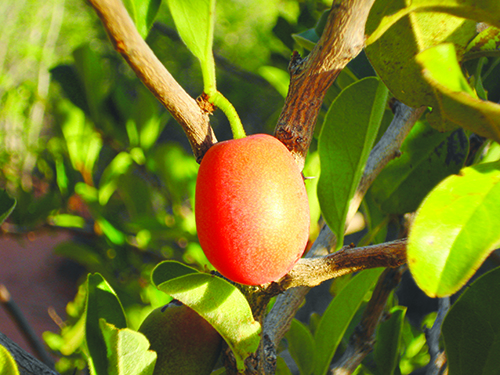LUISE HOFFMANNTHIS rather untidy shrub or tree occurs from about Otjiwarongo northwards mainly on plains and in sand or sandy loam.
It is most conspicuous between November and February when bearing plum-like red fruit. One often finds the way to this plant by following the trail of fruit peels dropped by baboons as they walk along. Other prominent features are the dark green simple leaves that are folded lengthwise, the tip being rounded and often notched. Initially densely downy, the leaves become almost hairless with age. The plant is armed with spine-tipped branchlets and rigid brown spines of 10 – 25 mm length in the leaf axils.
Names: G. Rote Wildpflaume; A. groot suurpruim; H. omumbeke; Ky. oshipeke ohimbuyu; Nd. oshipeke; Ximenia: named after the Spanish monk Xaver Ximenez who described the flora of Mexico during the 17th century; caffra: from ‘Kaffraria’, an old name for the Eastern Cape.
The large sour plum is a many-stemmed shrub or small tree, usually up to 3 m high, often with crooked or drooping branches. The brown-black bark is fissured lengthwise and across and slightly rough. On young branches it is pale brown and densely downy.
Small flowers with four cream to greenish petals, bearded on the inside and with recurved tips are borne singly or in clusters.
The olive-shaped, glossy dark-red fruit are the most visible characteristic of this plant. They are edible and very popular with baboons and birds. The thick skin, which gives the fruit a typical bitter almond smell and taste, should be discarded because of its high prussic acid content. In addition to their refreshingly tart taste they are rich in vitamin C, have a high potassium and protein content and can be made into a delicious cool drink or jelly. The large seeds contain a high percentage of non-drying oil, ximenia-oil, which can be used to soften leather and chapped feet, also as a cosmetic oil to soften the skin in general. The oil content is such that the kernels burn like miniature candles or the oil may be used for torches or oil-lamps. In north-eastern Namibia the seeds are cracked and the kernels placed in hot ash. When the oil begins to ooze out of the kernels they are squeezed or pounded into a paste and applied to wounds and burns. A root decoction can be taken to alleviate chest complaints.
The leaves are browsed by various game species.
Propagation: according to “Making the Most of Indigenous Trees” by Fanie and Julye-AnnVenter, the large sour plum may be propagated from fresh seed sown in a 5:1 mixture of river sand and compost that may not dry out during germination, which is erratic and may take 14 – 30 days. Plant into black nursery bags filled with the same soil mixture when they reach the two-leaf stage, taking care not to damage the long roots. Do not keep the seedlings in these bags for longer than one season before planting them out into sunny open ground. They can withstand modest frost and are drought-resistant. The shrub also makes an ideal container plant and may be pruned into a tidy shape. It will attract insects and birds to the garden and the foliage turns a deep purple colour before falling.
Stay informed with The Namibian – your source for credible journalism. Get in-depth reporting and opinions for
only N$85 a month. Invest in journalism, invest in democracy –
Subscribe Now!






